2014 KIA CEED wheel
[x] Cancel search: wheelPage 1157 of 1206
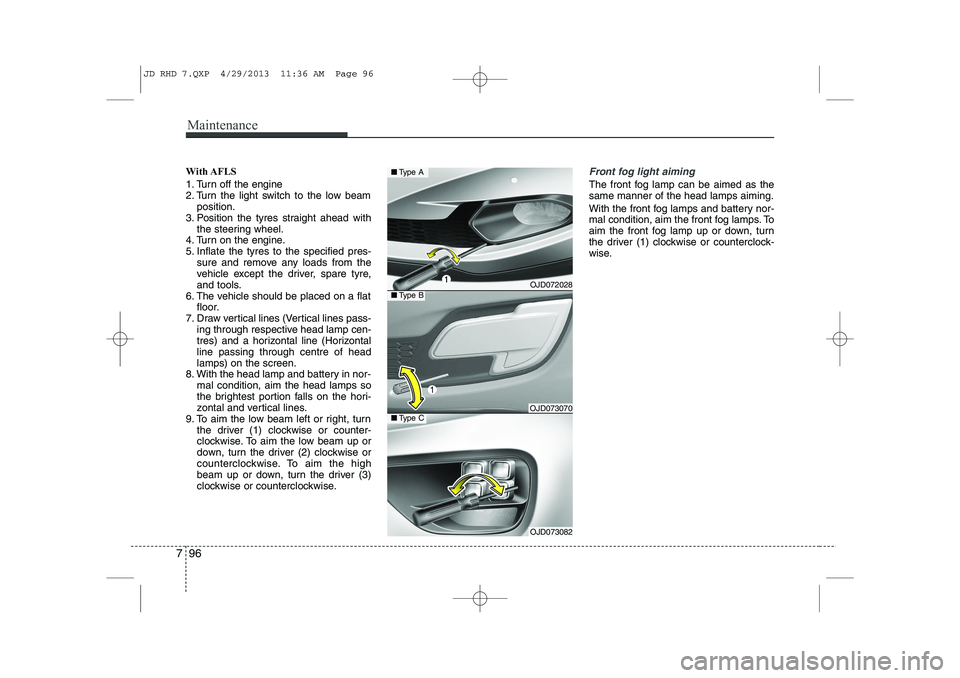
Maintenance
96
7
With AFLS
1. Turn off the engine
2. Turn the light switch to the low beam
position.
3. Position the tyres straight ahead with the steering wheel.
4. Turn on the engine.
5. Inflate the tyres to the specified pres- sure and remove any loads from the
vehicle except the driver, spare tyre,
and tools.
6. The vehicle should be placed on a flat floor.
7. Draw vertical lines (Vertical lines pass- ing through respective head lamp cen-
tres) and a horizontal line (Horizontalline passing through centre of headlamps) on the screen.
8. With the head lamp and battery in nor- mal condition, aim the head lamps so
the brightest portion falls on the hori-
zontal and vertical lines.
9. To aim the low beam left or right, turn the driver (1) clockwise or counter-
clockwise. To aim the low beam up or
down, turn the driver (2) clockwise or
counterclockwise. To aim the high
beam up or down, turn the driver (3)
clockwise or counterclockwise.Front fog light aiming
The front fog lamp can be aimed as the same manner of the head lamps aiming.
With the front fog lamps and battery nor-
mal condition, aim the front fog lamps. To
aim the front fog lamp up or down, turn
the driver (1) clockwise or counterclock-
wise.
OJD072028
OJD073070
OJD073082
■Type A
■Type B
■Type C
JD RHD 7.QXP 4/29/2013 11:36 AM Page 96
Page 1173 of 1206
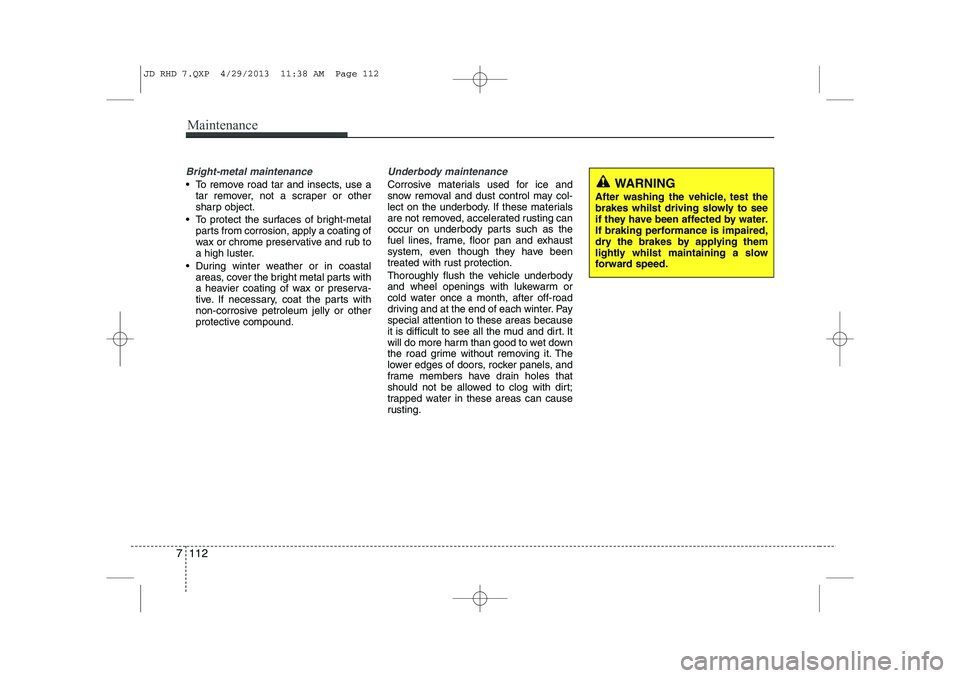
Maintenance
112
7
Bright-metal maintenance
To remove road tar and insects, use a
tar remover, not a scraper or other
sharp object.
To protect the surfaces of bright-metal parts from corrosion, apply a coating of
wax or chrome preservative and rub to
a high luster.
During winter weather or in coastal areas, cover the bright metal parts with
a heavier coating of wax or preserva-
tive. If necessary, coat the parts with
non-corrosive petroleum jelly or other
protective compound.
Underbody maintenance
Corrosive materials used for ice and
snow removal and dust control may col-
lect on the underbody. If these materials
are not removed, accelerated rusting can
occur on underbody parts such as the
fuel lines, frame, floor pan and exhaust
system, even though they have been
treated with rust protection.
Thoroughly flush the vehicle underbody
and wheel openings with lukewarm or
cold water once a month, after off-road
driving and at the end of each winter. Payspecial attention to these areas because
it is difficult to see all the mud and dirt. It
will do more harm than good to wet down
the road grime without removing it. The
lower edges of doors, rocker panels, and
frame members have drain holes that
should not be allowed to clog with dirt;
trapped water in these areas can cause
rusting.WARNING
After washing the vehicle, test the
brakes whilst driving slowly to see
if they have been affected by water.
If braking performance is impaired,
dry the brakes by applying them
lightly whilst maintaining a slow
forward speed.
JD RHD 7.QXP 4/29/2013 11:38 AM Page 112
Page 1174 of 1206
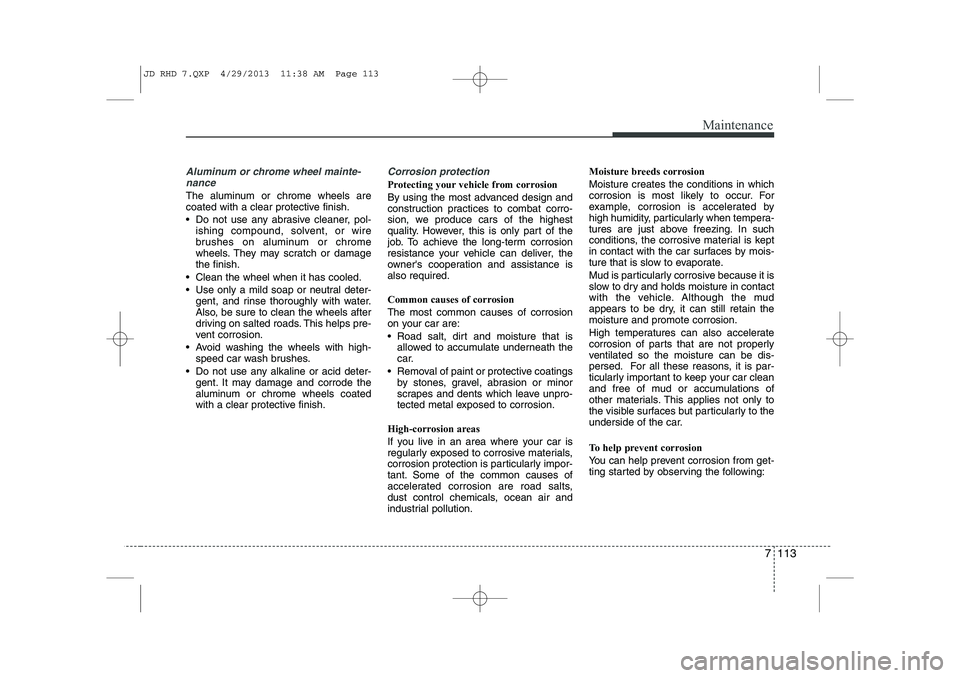
7 113
Maintenance
Aluminum or chrome wheel mainte-nance
The aluminum or chrome wheels are
coated with a clear protective finish.
Do not use any abrasive cleaner, pol- ishing compound, solvent, or wire
brushes on aluminum or chrome
wheels. They may scratch or damagethe finish.
Clean the wheel when it has cooled.
Use only a mild soap or neutral deter- gent, and rinse thoroughly with water.
Also, be sure to clean the wheels after
driving on salted roads. This helps pre-
vent corrosion.
Avoid washing the wheels with high- speed car wash brushes.
Do not use any alkaline or acid deter- gent. It may damage and corrode the
aluminum or chrome wheels coated
with a clear protective finish.
Corrosion protection
Protecting your vehicle from corrosion
By using the most advanced design and
construction practices to combat corro-
sion, we produce cars of the highest
quality. However, this is only part of the
job. To achieve the long-term corrosion
resistance your vehicle can deliver, the
owner's cooperation and assistance isalso required.
Common causes of corrosion The most common causes of corrosion
on your car are:
Road salt, dirt and moisture that isallowed to accumulate underneath the
car.
Removal of paint or protective coatings by stones, gravel, abrasion or minor
scrapes and dents which leave unpro-
tected metal exposed to corrosion.
High-corrosion areas
If you live in an area where your car is
regularly exposed to corrosive materials,
corrosion protection is particularly impor-
tant. Some of the common causes of
accelerated corrosion are road salts,
dust control chemicals, ocean air and
industrial pollution. Moisture breeds corrosion Moisture creates the conditions in which
corrosion is most likely to occur. For
example, corrosion is accelerated by
high humidity, particularly when tempera-
tures are just above freezing. In such
conditions, the corrosive material is kept
in contact with the car surfaces by mois-
ture that is slow to evaporate.
Mud is particularly corrosive because it is
slow to dry and holds moisture in contact
with the vehicle. Although the mud
appears to be dry, it can still retain themoisture and promote corrosion.
High temperatures can also accelerate
corrosion of parts that are not properly
ventilated so the moisture can be dis-
persed. For all these reasons, it is par-
ticularly important to keep your car clean
and free of mud or accumulations of
other materials. This applies not only to
the visible surfaces but particularly to the
underside of the car.
To help prevent corrosion
You can help prevent corrosion from get-
ting started by observing the following:
JD RHD 7.QXP 4/29/2013 11:38 AM Page 113
Page 1176 of 1206
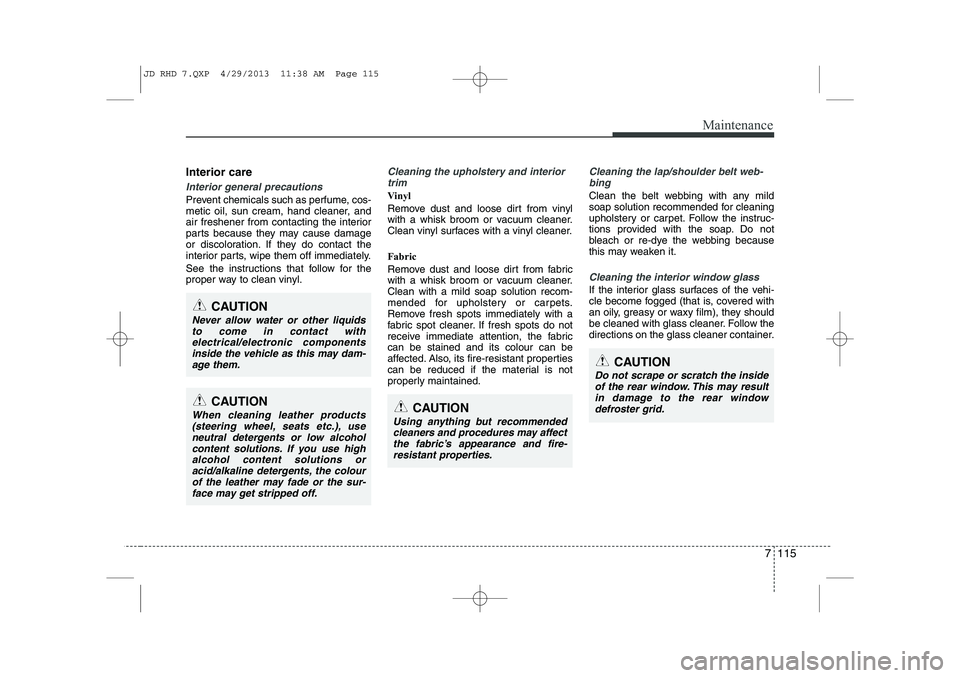
7 115
Maintenance
Interior care
Interior general precautions
Prevent chemicals such as perfume, cos-
metic oil, sun cream, hand cleaner, and
air freshener from contacting the interior
parts because they may cause damage
or discoloration. If they do contact the
interior parts, wipe them off immediately.
See the instructions that follow for the
proper way to clean vinyl.
Cleaning the upholstery and interiortrim
Vinyl
Remove dust and loose dirt from vinyl
with a whisk broom or vacuum cleaner.
Clean vinyl surfaces with a vinyl cleaner. Fabric
Remove dust and loose dirt from fabric
with a whisk broom or vacuum cleaner.Clean with a mild soap solution recom-
mended for upholstery or carpets.
Remove fresh spots immediately with a
fabric spot cleaner. If fresh spots do not
receive immediate attention, the fabriccan be stained and its colour can be
affected. Also, its fire-resistant properties
can be reduced if the material is not
properly maintained.
Cleaning the lap/shoulder belt web- bing
Clean the belt webbing with any mild
soap solution recommended for cleaning
upholstery or carpet. Follow the instruc-
tions provided with the soap. Do not
bleach or re-dye the webbing because
this may weaken it.
Cleaning the interior window glass
If the interior glass surfaces of the vehi-
cle become fogged (that is, covered with
an oily, greasy or waxy film), they should
be cleaned with glass cleaner. Follow the
directions on the glass cleaner container.
CAUTION
Never allow water or other liquidsto come in contact with
electrical/electronic components inside the vehicle as this may dam-age them.
CAUTION
Using anything but recommended
cleaners and procedures may affectthe fabric’s appearance and fire- resistant properties.
CAUTION
When cleaning leather products
(steering wheel, seats etc.), use neutral detergents or low alcoholcontent solutions. If you use highalcohol content solutions or
acid/alkaline detergents, the colourof the leather may fade or the sur-face may get stripped off.
CAUTION
Do not scrape or scratch the insideof the rear window. This may result
in damage to the rear windowdefroster grid.
JD RHD 7.QXP 4/29/2013 11:38 AM Page 115
Page 1181 of 1206
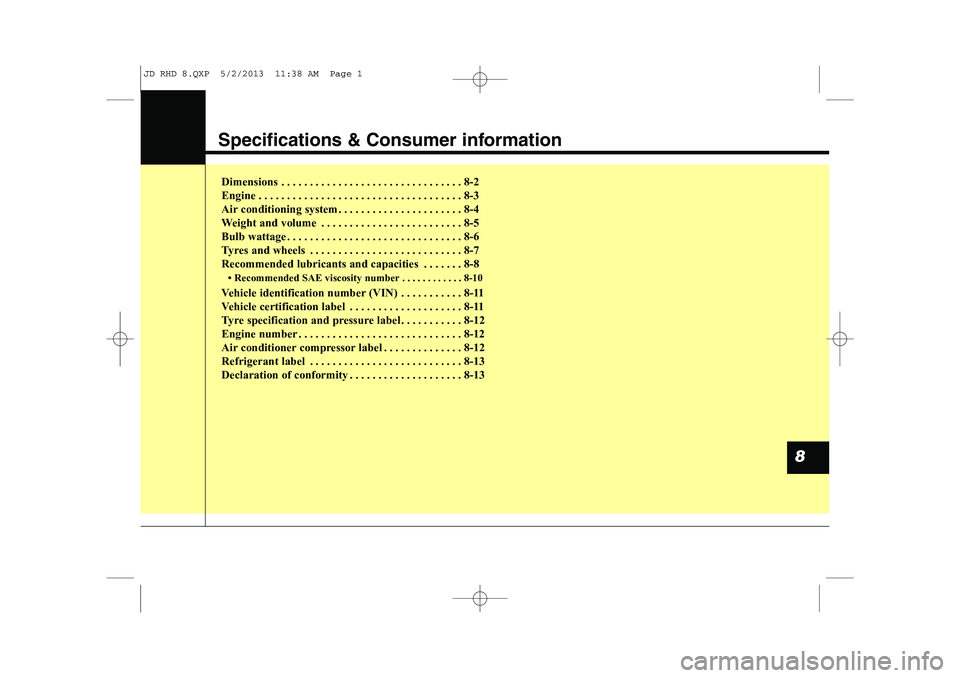
Specifications & Consumer information
Dimensions . . . . . . . . . . . . . . . . . . . . . . . . . . . . . . . . 8-2
Engine . . . . . . . . . . . . . . . . . . . . . . . . . . . . . . . . . . . . 8-3
Air conditioning system . . . . . . . . . . . . . . . . . . . . . . 8-4
Weight and volume . . . . . . . . . . . . . . . . . . . . . . . . . 8-5
Bulb wattage . . . . . . . . . . . . . . . . . . . . . . . . . . . . . . . 8-6
Tyres and wheels . . . . . . . . . . . . . . . . . . . . . . . . . . . 8-7
Recommended lubricants and capacities . . . . . . . 8-8
Page 1182 of 1206
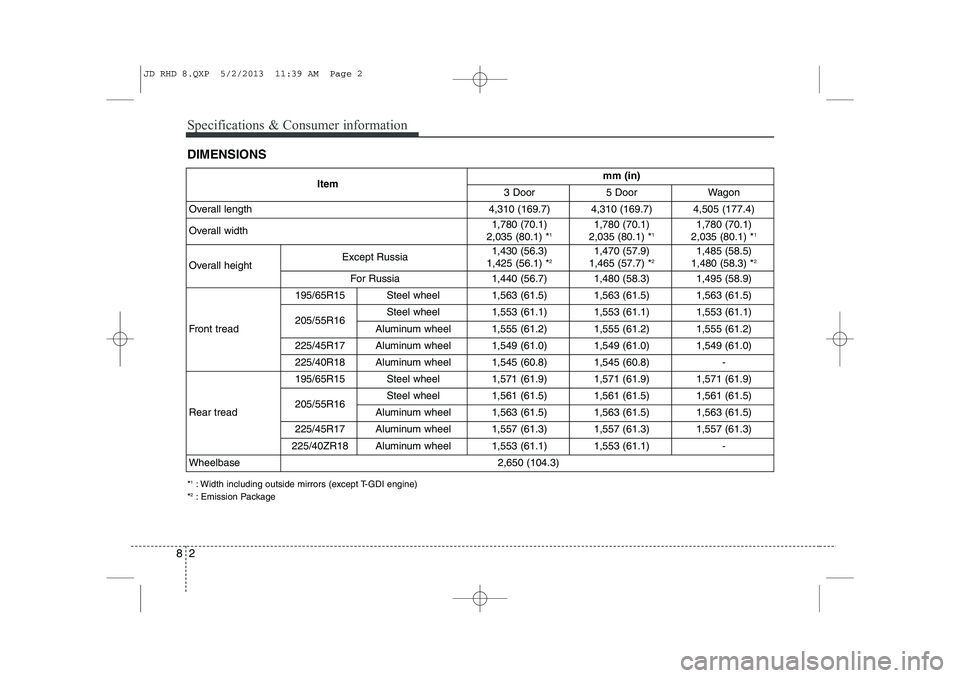
Specifications & Consumer information
2
8
DIMENSIONS
Itemmm (in)
3 Door 5 DoorWagon
Overall length4,310 (169.7)4,310 (169.7)4,505 (177.4)
Overall width1,780 (70.1)
2,035 (80.1) * 11,780 (70.1)
2,035 (80.1) * 11,780 (70.1)
2,035 (80.1) * 1
Overall height Except Russia1,430 (56.3)
1,425 (56.1) * 21,470 (57.9)
1,465 (57.7) * 21,485 (58.5)
1,480 (58.3) * 2
For Russia1,440 (56.7)1,480 (58.3)1,495 (58.9)
Front tread
195/65R15Steel wheel1,563 (61.5)1,563 (61.5)1,563 (61.5)
205/55R16Steel wheel1,553 (61.1)1,553 (61.1)1,553 (61.1)
Aluminum wheel1,555 (61.2)1,555 (61.2)1,555 (61.2)
225/45R17Aluminum wheel1,549 (61.0)1,549 (61.0)1,549 (61.0)
225/40R18Aluminum wheel1,545 (60.8)1,545 (60.8)-
Rear tread
195/65R15Steel wheel1,571 (61.9)1,571 (61.9)1,571 (61.9)
205/55R16Steel wheel1,561 (61.5)1,561 (61.5)1,561 (61.5)
Aluminum wheel1,563 (61.5)1,563 (61.5)1,563 (61.5)
225/45R17Aluminum wheel1,557 (61.3)1,557 (61.3)1,557 (61.3)
225/40ZR18Aluminum wheel1,553 (61.1)1,553 (61.1)-
Wheelbase2,650 (104.3)
*
1
: Width including outside mirrors (except T-GDI engine)
* 2
: Emission Package
JD RHD 8.QXP 5/2/2013 11:39 AM Page 2
Page 1187 of 1206

87
Specifications & Consumer information
TYRES AND WHEELS *1
: Load Index
* 2
: Speed Symbol
* 3
: For eco dynamics trim
ItemTyre sizeWheel
sizeLoad CapacitySpeed capacityInflation pressure bar(psi, kPa)Wheel lug nuttorque Kgf·m (lb·ft, N·m)
Normal loadMaximum load
LI * 1KgSS * 2Km/hFrontRear FrontRear
Full size
tyre
195/65R15* 36.0J×15 91615H2102.5
(36,250)2.5
(36,250)2.5
(36,250)2.5
(36,250)
9~11 (65~79, 88~107)
195/65R156.0J×15 91615H2102.2
(32,220)2.2
(32,220)2.2
(32,220)2.2
(32,220)
205/55R166.5J×1691615H2102.2
(32,220)2.2
(32,220)2.2
(32,220)2.2
(32,220)
225/45R177.0J×1791615V2402.2
(32,220)2.2
(32,220)2.2
(32,220)2.2
(32,220)
225/40ZR187.5J×1892630Y3002.2
(32,220)2.2
(32,220)2.2
(32,220)2.2
(32,220)
Compact
spare tyreT125/80D154.0T×1595690M1304.2
(60, 420)4.2
(60, 420)4.2
(60, 420)4.2
(60, 420)
T125/80D164.0T×1697730M1304.2
(60, 420)4.2
(60, 420)4.2
(60, 420)4.2
(60, 420)
JD RHD 8.QXP 5/2/2013 11:39 AM Page 7
Page 1198 of 1206
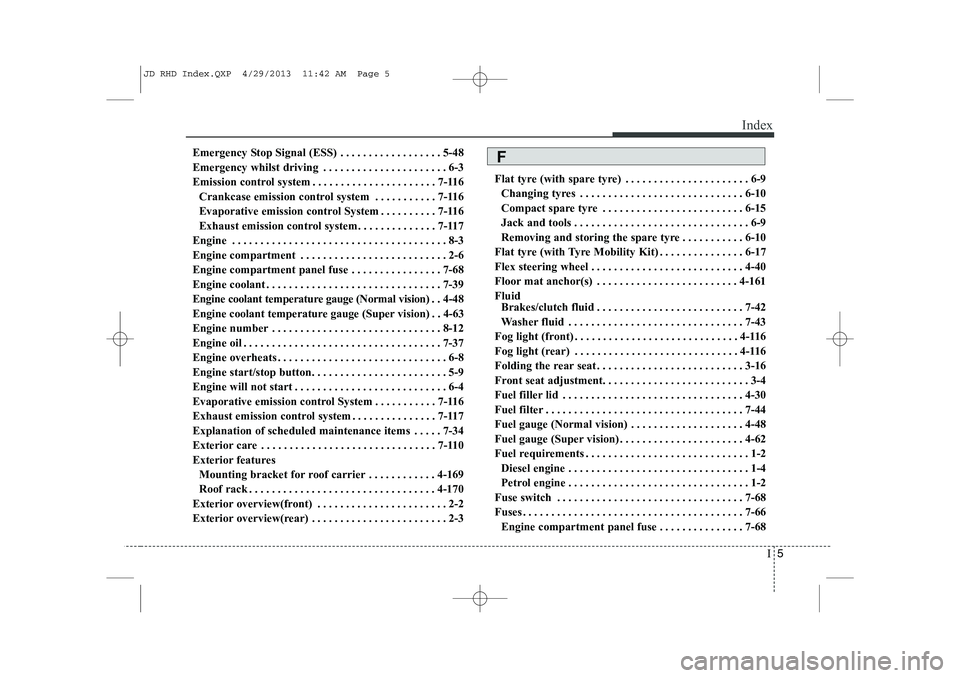
I5
Index
Emergency Stop Signal (ESS) . . . . . . . . . . . . . . . . . . 5-48
Emergency whilst driving . . . . . . . . . . . . . . . . . . . . . . 6-3
Emission control system . . . . . . . . . . . . . . . . . . . . . . 7-116
Crankcase emission control system . . . . . . . . . . . 7-116
Evaporative emission control System . . . . . . . . . . 7-116
Exhaust emission control system. . . . . . . . . . . . . . 7-117
Engine . . . . . . . . . . . . . . . . . . . . . . . . . . . . . . . . . . . . . . 8-3
Engine compartment . . . . . . . . . . . . . . . . . . . . . . . . . . 2-6
Engine compartment panel fuse . . . . . . . . . . . . . . . . 7-68
Engine coolant . . . . . . . . . . . . . . . . . . . . . . . . . . . . . . . 7-39
Engine coolant temperature gauge (Normal vision) . . 4-48
Engine coolant temperature gauge (Super vision) . . 4-63
Engine number . . . . . . . . . . . . . . . . . . . . . . . . . . . . . . 8-12
Engine oil . . . . . . . . . . . . . . . . . . . . . . . . . . . . . . . . . . . 7-37
Engine overheats . . . . . . . . . . . . . . . . . . . . . . . . . . . . . . 6-8
Engine start/stop button. . . . . . . . . . . . . . . . . . . . . . . . 5-9
Engine will not start . . . . . . . . . . . . . . . . . . . . . . . . . . . 6-4
Evaporative emission control System . . . . . . . . . . . 7-116
Exhaust emission control system . . . . . . . . . . . . . . . 7-117
Explanation of scheduled maintenance items . . . . . 7-34
Exterior care . . . . . . . . . . . . . . . . . . . . . . . . . . . . . . . 7-110
Exterior features
Mounting bracket for roof carrier . . . . . . . . . . . . 4-169
Roof rack . . . . . . . . . . . . . . . . . . . . . . . . . . . . . . . . . 4-170
Exterior overview(front) . . . . . . . . . . . . . . . . . . . . . . . 2-2
Exterior overview(rear) . . . . . . . . . . . . . . . . . . . . . . . . 2-3 Flat tyre (with spare tyre) . . . . . . . . . . . . . . . . . . . . . . 6-9
Changing tyres . . . . . . . . . . . . . . . . . . . . . . . . . . . . . 6-10
Compact spare tyre . . . . . . . . . . . . . . . . . . . . . . . . . 6-15
Jack and tools . . . . . . . . . . . . . . . . . . . . . . . . . . . . . . . 6-9
Removing and storing the spare tyre . . . . . . . . . . . 6-10
Flat tyre (with Tyre Mobility Kit) . . . . . . . . . . . . . . . 6-17
Flex steering wheel . . . . . . . . . . . . . . . . . . . . . . . . . . . 4-40
Floor mat anchor(s) . . . . . . . . . . . . . . . . . . . . . . . . . 4-161Fluid Brakes/clutch fluid . . . . . . . . . . . . . . . . . . . . . . . . . . 7-42
Washer fluid . . . . . . . . . . . . . . . . . . . . . . . . . . . . . . . 7-43
Fog light (front) . . . . . . . . . . . . . . . . . . . . . . . . . . . . . 4-116
Fog light (rear) . . . . . . . . . . . . . . . . . . . . . . . . . . . . . 4-116
Folding the rear seat . . . . . . . . . . . . . . . . . . . . . . . . . . 3-16
Front seat adjustment. . . . . . . . . . . . . . . . . . . . . . . . . . 3-4
Fuel filler lid . . . . . . . . . . . . . . . . . . . . . . . . . . . . . . . . 4-30
Fuel filter . . . . . . . . . . . . . . . . . . . . . . . . . . . . . . . . . . . 7-44
Fuel gauge (Normal vision) . . . . . . . . . . . . . . . . . . . . 4-48
Fuel gauge (Super vision) . . . . . . . . . . . . . . . . . . . . . . 4-62
Fuel requirements . . . . . . . . . . . . . . . . . . . . . . . . . . . . . 1-2 Diesel engine . . . . . . . . . . . . . . . . . . . . . . . . . . . . . . . . 1-4
Petrol engine . . . . . . . . . . . . . . . . . . . . . . . . . . . . . . . . 1-2
Fuse switch . . . . . . . . . . . . . . . . . . . . . . . . . . . . . . . . . 7-68
Fuses . . . . . . . . . . . . . . . . . . . . . . . . . . . . . . . . . . . . . . . 7-66 Engine compartment panel fuse . . . . . . . . . . . . . . . 7-68F
JD RHD Index.QXP 4/29/2013 11:42 AM Page 5